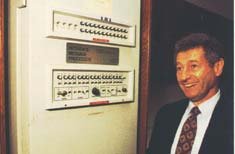1968
Assignment of tasks
With help of the experience from the mini-network, which has been set up at NPL by Donald Watts Davies one year earlier, the plans for an ARPA network are getting more precise.In 1968, the research department of ARPA, governed by Licklider, calls for proposals of the different components needed for the network.

The first IMP

Stanford Research Institute (SRI) receives the assignment of enunciating the specifications for the new network. BBN (Bolt, Beranek and Newman) gets the tender for developing the technology for packet switching, to be exact, for the development of Interface Message Processors (IMPs) in December. Robert E. Kahn was responsible for their crucial system design of the ARPANET. Only a short time before, Kahn asked for time off from MIT (Massachusetts Institute of Technology) to work for “Project ARPANET” all out.
The purpose of the IMPs, which can be seen as the precursor of a router, was to establish a connection on the first layer between two computers (hosts) connected via a telephone line.
The purpose of the IMPs, which can be seen as the precursor of a router, was to establish a connection on the first layer between two computers (hosts) connected via a telephone line.
1968
Net
Facts
Facts


1968
Other
Events
Events
On January 9, SURVEYOR VII is the first real spacecraft that landed on the moon undamaged.
The three super powers USA, USSR and Great Britain sign the Treaty on the Non-proliferation of Nuclear Weapons (NPT)
On April 4, the civil rights leader Dr. Martin Luther King is shot during a rally by an unknown assassin.
On May 3 student protests arise in Parisian universities due to the closing of a faculty.


